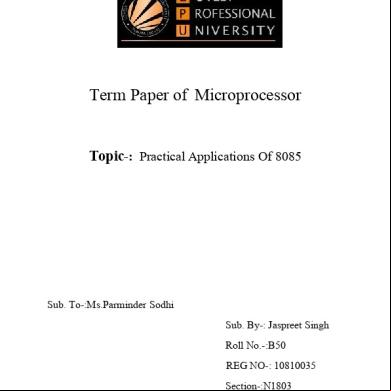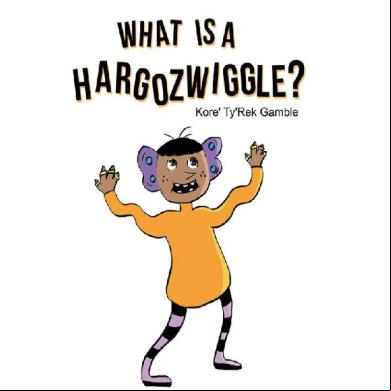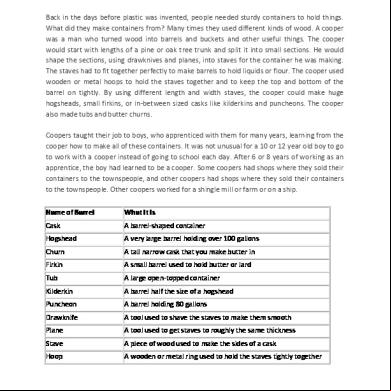What Is A Practical Application Of Boyle k6v10
This document was ed by and they confirmed that they have the permission to share it. If you are author or own the copyright of this book, please report to us by using this report form. Report 445h4w
Overview 1s532p
& View What Is A Practical Application Of Boyle as PDF for free.
More details 6h715l
- Words: 666
- Pages: 3
What is a practical application of Boyle's law? A: QUICK ANSWER
One practical application of Boyle's law is drawing fluid into a syringe. Pulling back on the plunger increases the interior volume of the syringe and reduces its pressure. The fluid outside the syringe is sucked into the barrel until the interior and exterior pressure are balanced.
What is an application of Charles' Law? A: QUICK ANSWER
An application of Charles' Law is a floating hot air balloon. A torch heats the air inside the balloon causing the air particles to move faster and disperse, making the air in the balloon less dense than the surrounding air so that the balloon floats. CONTINUE READING KEEP LEARNING
What is a Charles's Law lab?
What are examples of Charles' law?
What is the practical application of Charles's law?
FULL ANSWER
Charles' Law explains the relationship between the volume and temperature of a gas. It states that heating a gas while holding its pressure constant results in an increase in the
volume of the gas. Similarly, the volume of the gas decreases when the temperature decreases. A hot air balloon is an application of Charles' Law. The fuel used heats the air inside the balloon. Heating the air increases the speed of its gas particles in air, so they move faster and spread out, according to kinetic molecular theory as described by the University of California. This causes the gas inside the balloon to take up more space. The speed of movement of the gas particles as well as their dispersal causes the air inside the balloon to become less dense than the air surrounding it. As a result, the balloon floats. In short, the hot air in the balloon rises because of its decreased density.
What is an example of GayLussac's Law in everyday life? A: QUICK ANSWER
An example of Gay-Lussac's Law in everyday life is the shooting of a gun. As gunpowder burns, it creates superheated gas, which forces the bullet out of the gun barrel following Gay-Lussac's Law. Other everyday life examples can be found in things that use gas and pressure in order to function. CONTINUE READING KEEP LEARNING
How is the ideal gas law used in everyday life?
What is an example of the law of conservation of mass?
What are some examples of operant conditioning in everyday life?
FULL ANSWER
All gases have different properties that can be observed via the senses. These properties include temperature, mass, volume and the pressure contained within the gas. Scientists have discovered that all of these properties within a gas are related to one another, and it is these properties that determine the gas' state. Charles and Gay-Lussac were two French scientists who first discovered, and then investigated, the relationship between temperature and volume in gases. The temperature and volume of a gas are always found at constant numbers of both moles and pressure. This rule is now called the Charles and Gay-Lussac Law to honor the scientists. Originally, Charles did the work and then Gay-Lussac verified the work. They both found that as pressure held constant in the gas, the volume was equal to the constant times the temperature. This formula is known as V (volume) = Constant (C) multiplied by T (temperature).
Avogadro's Law is used in many careers and in many fields of work. In zoos, every once in a while, you may spot a balloon sales man/woman. He or she must make sure to distribute the amount of helium (mass) evenly in each balloon. It is obvious when he or she made a mistake when one balloon is much larger in size (volume) than another balloon. Avogadro's Law can also be shown with those that work with propane or natural gas. If they fill to much of the gas into the container, then the gas will cause the container to burst. This happens if there is a increasing mass but the the volume stays the same.
One practical application of Boyle's law is drawing fluid into a syringe. Pulling back on the plunger increases the interior volume of the syringe and reduces its pressure. The fluid outside the syringe is sucked into the barrel until the interior and exterior pressure are balanced.
What is an application of Charles' Law? A: QUICK ANSWER
An application of Charles' Law is a floating hot air balloon. A torch heats the air inside the balloon causing the air particles to move faster and disperse, making the air in the balloon less dense than the surrounding air so that the balloon floats. CONTINUE READING KEEP LEARNING
What is a Charles's Law lab?
What are examples of Charles' law?
What is the practical application of Charles's law?
FULL ANSWER
Charles' Law explains the relationship between the volume and temperature of a gas. It states that heating a gas while holding its pressure constant results in an increase in the
volume of the gas. Similarly, the volume of the gas decreases when the temperature decreases. A hot air balloon is an application of Charles' Law. The fuel used heats the air inside the balloon. Heating the air increases the speed of its gas particles in air, so they move faster and spread out, according to kinetic molecular theory as described by the University of California. This causes the gas inside the balloon to take up more space. The speed of movement of the gas particles as well as their dispersal causes the air inside the balloon to become less dense than the air surrounding it. As a result, the balloon floats. In short, the hot air in the balloon rises because of its decreased density.
What is an example of GayLussac's Law in everyday life? A: QUICK ANSWER
An example of Gay-Lussac's Law in everyday life is the shooting of a gun. As gunpowder burns, it creates superheated gas, which forces the bullet out of the gun barrel following Gay-Lussac's Law. Other everyday life examples can be found in things that use gas and pressure in order to function. CONTINUE READING KEEP LEARNING
How is the ideal gas law used in everyday life?
What is an example of the law of conservation of mass?
What are some examples of operant conditioning in everyday life?
FULL ANSWER
All gases have different properties that can be observed via the senses. These properties include temperature, mass, volume and the pressure contained within the gas. Scientists have discovered that all of these properties within a gas are related to one another, and it is these properties that determine the gas' state. Charles and Gay-Lussac were two French scientists who first discovered, and then investigated, the relationship between temperature and volume in gases. The temperature and volume of a gas are always found at constant numbers of both moles and pressure. This rule is now called the Charles and Gay-Lussac Law to honor the scientists. Originally, Charles did the work and then Gay-Lussac verified the work. They both found that as pressure held constant in the gas, the volume was equal to the constant times the temperature. This formula is known as V (volume) = Constant (C) multiplied by T (temperature).
Avogadro's Law is used in many careers and in many fields of work. In zoos, every once in a while, you may spot a balloon sales man/woman. He or she must make sure to distribute the amount of helium (mass) evenly in each balloon. It is obvious when he or she made a mistake when one balloon is much larger in size (volume) than another balloon. Avogadro's Law can also be shown with those that work with propane or natural gas. If they fill to much of the gas into the container, then the gas will cause the container to burst. This happens if there is a increasing mass but the the volume stays the same.










